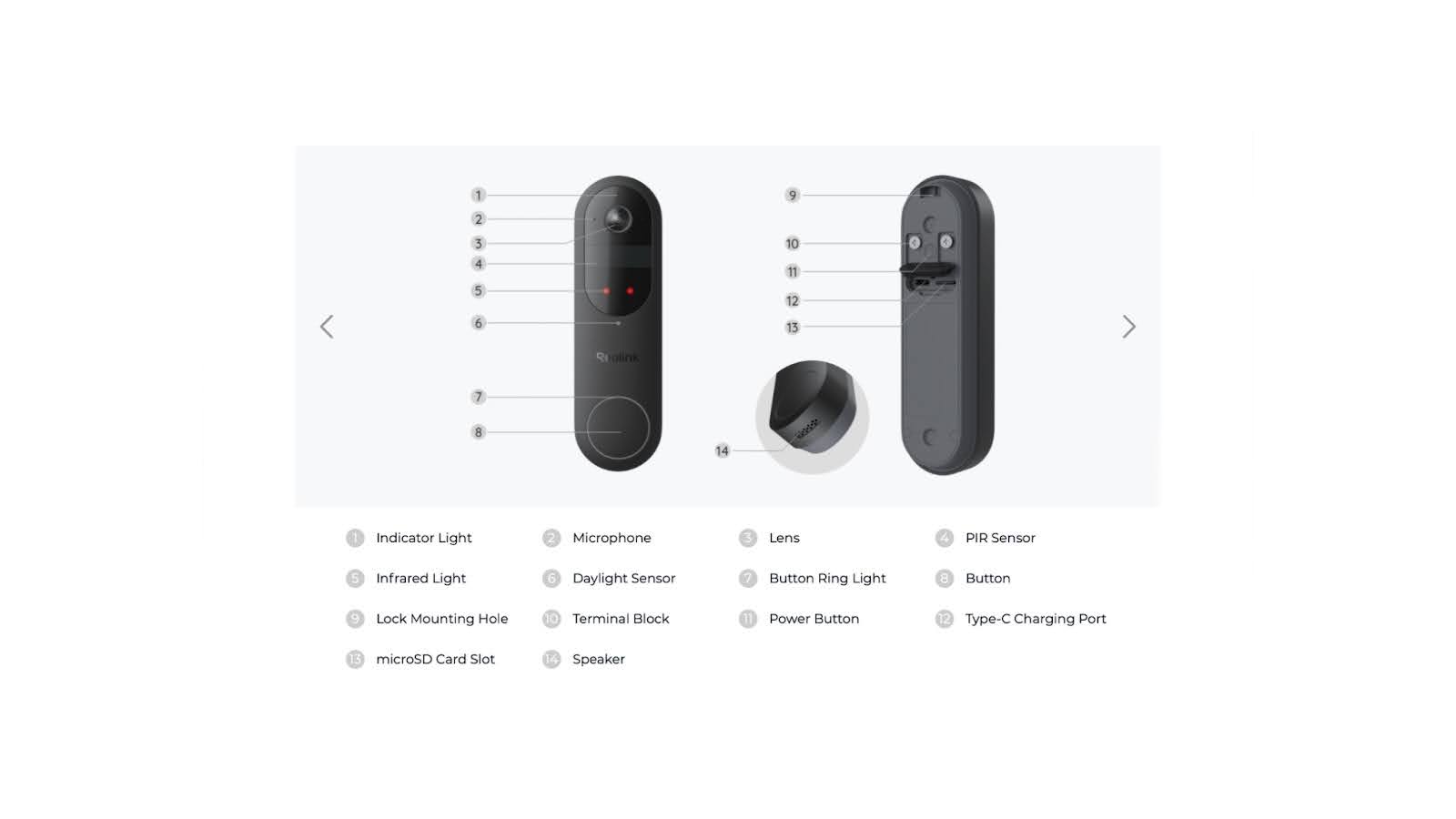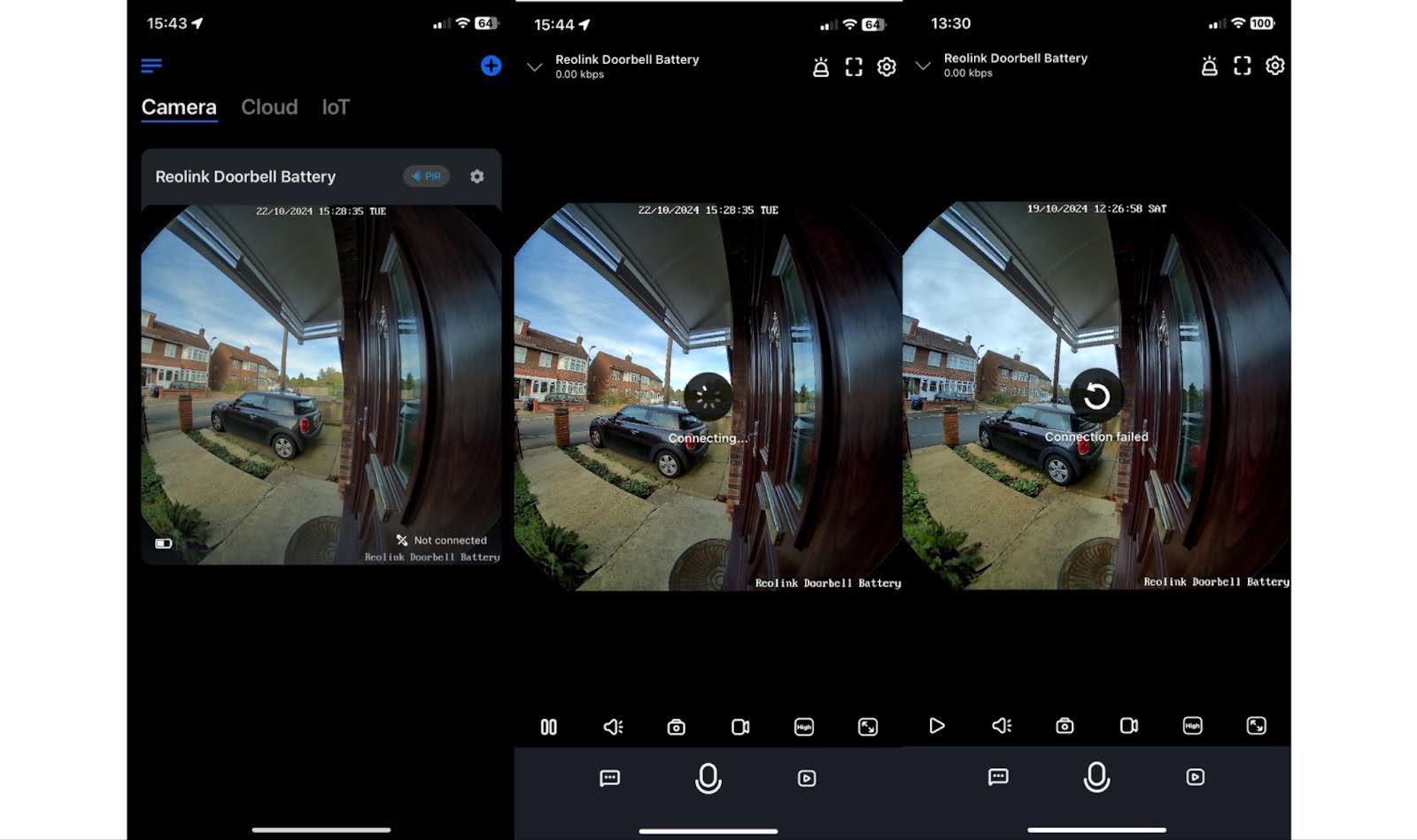Reolink Doorbell (Battery): one-minute review
The Reolink Doorbell (Battery) is a wireless video doorbell that’s solidly built and works without a subscription, but has a few drawbacks when it comes to video latency and smart home compatibility.
The built quality of the Reolink Doorbell (Battery) impresses as soon as you take it out of the box. Reolink has years of experience making external security cameras (including the recently launched Reolink Altas PT), and has brought that experience to bear on this product.
It feels substantial and purposeful when compared to something like the Aqara video doorbell G4 or the Ring Battery video doorbell Plus with its wafer-thin metal front cover. Superior weather protection is most welcome here in the UK, especially if you have a front entrance exposed to the elements.
It boasts a feature set that we’ve come to expect from the best video doorbells, including package detection, head-to-toe field of view, night vision, and 2K resolution. Plus, unlike some competing products, it works subscription-free; there is no need to store your video in the cloud as you can keep it on a microSD card within the unit (purchased separately).
With its rechargeable battery and Wi-Fi capabilities, installation can be as simple as downloading the app to your phone, drilling two holes, and attaching the doorbell to the door or wall. Reolink produces a range of devices including security cameras, hubs and network video recorders, and the lineage of this battery-powered doorbell is easy to trace.
However, The Reolink Doorbell (Battery) misses the mark in a few key areas; it has limited home automation connectivity and a slow and unreliable connection between the app and the doorbell, plus it’s easily removed from the wall.
Reolink Doorbell (Battery): price and availability
- List price: $145.99 / £159.99 / AU$186.99
- Chimes and smart hub sold separately
The Reolink Doorbell (Battery) launched in September 2024 for $145.99 / £159.99 / AU$186.99, and at the time of writing the company is holding a sale that knocks around 10% off its list price. It can be bought direct from Reolink’s online store (which ships worldwide) or from Amazon.
There are also Reolink chimes that let you hear the doorbell easily from anywhere in your home. These cost $19.99 / £23.99 / AU$49.99 each.
Reolink offers a compatible hub for $99.99 / £99.99 / AU$199.99, but I was disappointed that the brand’s solar panels do not appear compatible with the doorbell. It’s also not clear how to hardwire the doorbell if you do not have an existing doorbell circuit.
Reolink Doorbell (Battery): specs
| Dimensions | 6.3 x 1.9 x 1.2in / 16 x 4.8 x 2.95cm |
| Colors | Black, white (US-only) |
| Hub required | No |
| Smart home compatibility | Amazon Alexa / Google Assistant |
| Connectivity | Wi-Fi 2.5GHz/5GHz |
| Mobile compatibility | iOS, Android |
| Field of view | 150 degrees horizontal, 150 degrees vertical, 180 degrees diagonal |
| Video resolution | 2,048 x 2,048 (4MP) at 15fps |
Reolink Doorbell (Battery): design
- Sleek and attractive design
- Battery is not removable
The Reolink Doorbell (Battery) is a pill-shaped device topped by the camera and sensor housing with a sizeable round button on the lower half. It’s simple and unobtrusive, opting for a less boxy form factor than the market-leading Ring doorbells have to offer. It’s robustly built with long-term outdoor use in mind but has a few quirks that make it a less-than-optimal choice for some households.
It’s possible to tell quite a lot about a product and the company that produces it from the box that it comes in. I like a good box, and appreciate the time and effort required to design it; Reolink ‘gives good box’.
The manual with readable text larger than that found on microfilm impressed me, but the paper template for drilling the holes in your door/wall is a curious inclusion. If you can’t figure out where the holes need to go using the provided plates and screws I would suggest that you put the tools down, hold your hands aloft, and step away from the power drill.
The USB-C charge port is sensibly placed about halfway up the back of the doorbell under a protective rubber flap. Lifting the flap also revealed the MicroSD port into which I inserted a spare card and the supplied USB-C cable.

I admired the nicely illuminated doorbell button and then…
“Welcome to Reolink, please install the Reolink app and scan the QR code on the camera,” said the nice lady on the doorbell.
“No thank you, I am going to bed now,” said I, but the doorbell had other ideas. “Willkommen bei Reolink, bitte installieren Sie die Reolink-App und scannen Sie den QR-Code auf der Kamera“, sagte die nette Dame an der Türklingel.
I replied to the now very annoying lady using all of the four-letter Anglo Saxon words I could think of, hoping that it would shut up after a while, but no – it repeated the same message in six languages again and again and again. Further frustration ensued when I searched for a QR code to scan since the message did not specify “scan the QR code from within the app”.
Eventually, I found the rather hidden power button and consulted the manual to find that it needed holding down for a few seconds to power down. All the while the doorbell is bellowing like a Eurovision score round. Who thought all of that was a good idea?
Installing the doorbell in battery mode after charging it was simple enough, but I did notice that the mounting plate does not allow for powered installation where a power cable does not present itself directly behind the doorbell. It’s unlikely that existing doorbell wiring will be at the correct height, let alone the right location, meaning the power wire will most likely need to enter the unit from one side or the other and there are no slots in the mounting plate to allow for this.
The two major design flaws are the non-removable rechargeable battery and the ease with which the doorbell can be removed from the wall. I appreciate that using widely available removable rechargeable batteries restricts design choices, but everything else about the doorbell is built to last except for the battery.
Far worse is the ease with which the doorbell can be removed from the mounting plate. Yes, Reolink provides a sturdy removal tool, but you can remove it with a paperclip and, more worryingly, you can also remove the MicroSD card.
Reolink Doorbell (Battery): performance
- Mobile app is easy to navigate, but a little clunky
- Connecting to doorbell via app is slow
- Battery life is shorter than many other doorbells
As much as I like the build quality and Reolink’s attention to detail, it has to be said that connecting to the doorbell through the application is very slow. While the app is uncluttered and easy to navigate, some of the settings could be labeled more clearly. For instance, why are the video quality settings called ‘Clear’, ‘Balanced’ and ‘Fluent’, especially when the onscreen icon uses the unpretentious ‘High’, ‘Mid’ and ‘Low’ descriptors?
Drawing the privacy mask for your location is a pain, as you can’t see exactly what you’re doing when your comparatively large finger is blocking the screen. Reviewing video is also a bit clunky as it only displays the current day’s captures. If you want to see what happened the previous day you need to change the date and then wait for it to load.
The doorbell has been designed to conserve the battery wherever possible by only capturing video when the unit detects movement. This is a laudable design principle but as is often the case, it affects the performance; its standby mode leads to a longer connection time as it boots up. Two or three seconds is the usual connection period on other video doorbells and cameras that I have experienced, but the Reolink takes 5-10 seconds. Occasionally, it does not connect at all, which is very frustrating.
The seeds of doubt germinate as the battery also doesn’t seem to last as long as the other doorbells that I have tested. The Reolink website states “the 7,000mAh built-in battery provides up to five months of protection,” although they do caveat that this conclusion is based on testing “under lab conditions with 20 triggers per day, each recording lasting eight seconds.” I’m willing to accept that the battery won’t last quite so long once I have finished my testing, but five months is, at best, optimistic.

Reolink provides software for both Windows and OSX which is commendable; I spend most of my day at the computer and interacting with the doorbell through the phone app is less than ideal. It’s much easier to see the video output on a larger screen and the aliasing is not such an issue when the camera quality is set to high (or ‘Fluent’). It goes some way toward redemption for having such limited home automation capabilities. The night vision is darker than on other doorbells which is a bit of a double-edged sword. It is sometimes difficult to see what has been captured, but on the other hand, it does not trigger unnecessarily when the security light on the house opposite lights up like other doorbells I’ve tested.
I have mixed feelings, ultimately, about the Reolink doorbell (battery). I want to believe in this product but at its price and with its software being so middling, it’s likely to be a somewhat disappointing purchase.
Should you buy the Reolink Doorbell (Battery)?
Buy it if
Don’t buy it if
Reolink Doorbell (Battery): also consider
How I tested the Reolink Doorbell (Battery)
- I tested the phone application and OSX application
- I tested package recognition
- I compared response times and video output to other smart video doorbells
- I attempted to add it to Google Home
- I attempted to add it to Apple HomeKit using Homebridge
- I accessed the doorbell remotely via 4G and Wi-Fi
The test environment consisted of three smart doorbells (including the Reolink) all connected to the same Wi-Fi network. All doorbells were accessed via their accompanying applications during the testing for this review. The contents of the MicroSD cards were compared for file size and capture frequency (how often the doorbell captures video). The attempts to connect to Google Home and Apple HomeKit via Homebridge were time-limited to an hour each.
The drawback of the ‘only capture when detecting movement’ paradigm is that it is not possible to review the whole day’s video to investigate detection misfires or failures. The privacy mask seemed to work really well, for example, but conversely, maybe it was not picking up everything that it should. Still, I checked to my best ability when I knew there was outside activity and by acting out my own doorbell-ringing scenarios.
I’ve been using smart home devices for several years now, and have a whopping 30+ years of tech enthusiasm and experience under my belt. Read more about how we test.
First reviewed November 2024
Leave A Comment
You must be logged in to post a comment.